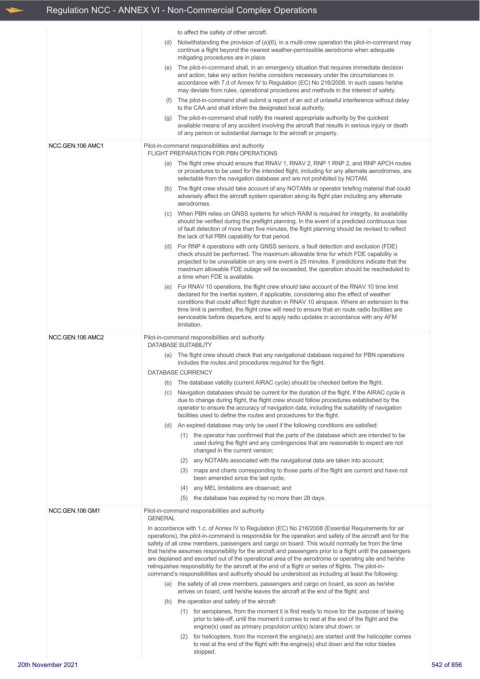Page 542 - UK Air Operations Regulations (Consolidated) 201121
P. 542
~
~ Regulation NCC - ANNEX VI - Non-Commercial Complex Operations Centrik
to affect the safety of other aircraft.
(d) Notwithstanding the provision of (a)(6), in a multi-crew operation the pilot-in-command may
continue a flight beyond the nearest weather-permissible aerodrome when adequate
mitigating procedures are in place.
(e) The pilot-in-command shall, in an emergency situation that requires immediate decision
and action, take any action he/she considers necessary under the circumstances in
accordance with 7.d of Annex IV to Regulation (EC) No 216/2008. In such cases he/she
may deviate from rules, operational procedures and methods in the interest of safety.
(f) The pilot-in-command shall submit a report of an act of unlawful interference without delay
to the CAA and shall inform the designated local authority.
(g) The pilot-in-command shall notify the nearest appropriate authority by the quickest
available means of any accident involving the aircraft that results in serious injury or death
of any person or substantial damage to the aircraft or property.
NCC.GEN.106 AMC1 Pilot-in-command responsibilities and authority
FLIGHT PREPARATION FOR PBN OPERATIONS
(a) The flight crew should ensure that RNAV 1, RNAV 2, RNP 1 RNP 2, and RNP APCH routes
or procedures to be used for the intended flight, including for any alternate aerodromes, are
selectable from the navigation database and are not prohibited by NOTAM.
(b) The flight crew should take account of any NOTAMs or operator briefing material that could
adversely affect the aircraft system operation along its flight plan including any alternate
aerodromes.
(c) When PBN relies on GNSS systems for which RAIM is required for integrity, its availability
should be verified during the preflight planning. In the event of a predicted continuous loss
of fault detection of more than five minutes, the flight planning should be revised to reflect
the lack of full PBN capability for that period.
(d) For RNP 4 operations with only GNSS sensors, a fault detection and exclusion (FDE)
check should be performed. The maximum allowable time for which FDE capability is
projected to be unavailable on any one event is 25 minutes. If predictions indicate that the
maximum allowable FDE outage will be exceeded, the operation should be rescheduled to
a time when FDE is available.
(e) For RNAV 10 operations, the flight crew should take account of the RNAV 10 time limit
declared for the inertial system, if applicable, considering also the effect of weather
conditions that could affect flight duration in RNAV 10 airspace. Where an extension to the
time limit is permitted, the flight crew will need to ensure that en route radio facilities are
serviceable before departure, and to apply radio updates in accordance with any AFM
limitation.
NCC.GEN.106 AMC2 Pilot-in-command responsibilities and authority
DATABASE SUITABILITY
(a) The flight crew should check that any navigational database required for PBN operations
includes the routes and procedures required for the flight.
DATABASE CURRENCY
(b) The database validity (current AIRAC cycle) should be checked before the flight.
(c) Navigation databases should be current for the duration of the flight. If the AIRAC cycle is
due to change during flight, the flight crew should follow procedures established by the
operator to ensure the accuracy of navigation data, including the suitability of navigation
facilities used to define the routes and procedures for the flight.
(d) An expired database may only be used if the following conditions are satisfied:
(1) the operator has confirmed that the parts of the database which are intended to be
used during the flight and any contingencies that are reasonable to expect are not
changed in the current version;
(2) any NOTAMs associated with the navigational data are taken into account;
(3) maps and charts corresponding to those parts of the flight are current and have not
been amended since the last cycle;
(4) any MEL limitations are observed; and
(5) the database has expired by no more than 28 days.
NCC.GEN.106 GM1 Pilot-in-command responsibilities and authority
GENERAL
In accordance with 1.c. of Annex IV to Regulation (EC) No 216/2008 (Essential Requirements for air
operations), the pilot-in-command is responsible for the operation and safety of the aircraft and for the
safety of all crew members, passengers and cargo on board. This would normally be from the time
that he/she assumes responsibility for the aircraft and passengers prior to a flight until the passengers
are deplaned and escorted out of the operational area of the aerodrome or operating site and he/she
relinquishes responsibility for the aircraft at the end of a flight or series of flights. The pilot-in-
command’s responsibilities and authority should be understood as including at least the following:
(a) the safety of all crew members, passengers and cargo on board, as soon as he/she
arrives on board, until he/she leaves the aircraft at the end of the flight; and
(b) the operation and safety of the aircraft:
(1) for aeroplanes, from the moment it is first ready to move for the purpose of taxiing
prior to take-off, until the moment it comes to rest at the end of the flight and the
engine(s) used as primary propulsion unit(s) is/are shut down; or
(2) for helicopters, from the moment the engine(s) are started until the helicopter comes
to rest at the end of the flight with the engine(s) shut down and the rotor blades
stopped.
20th November 2021 542 of 856

